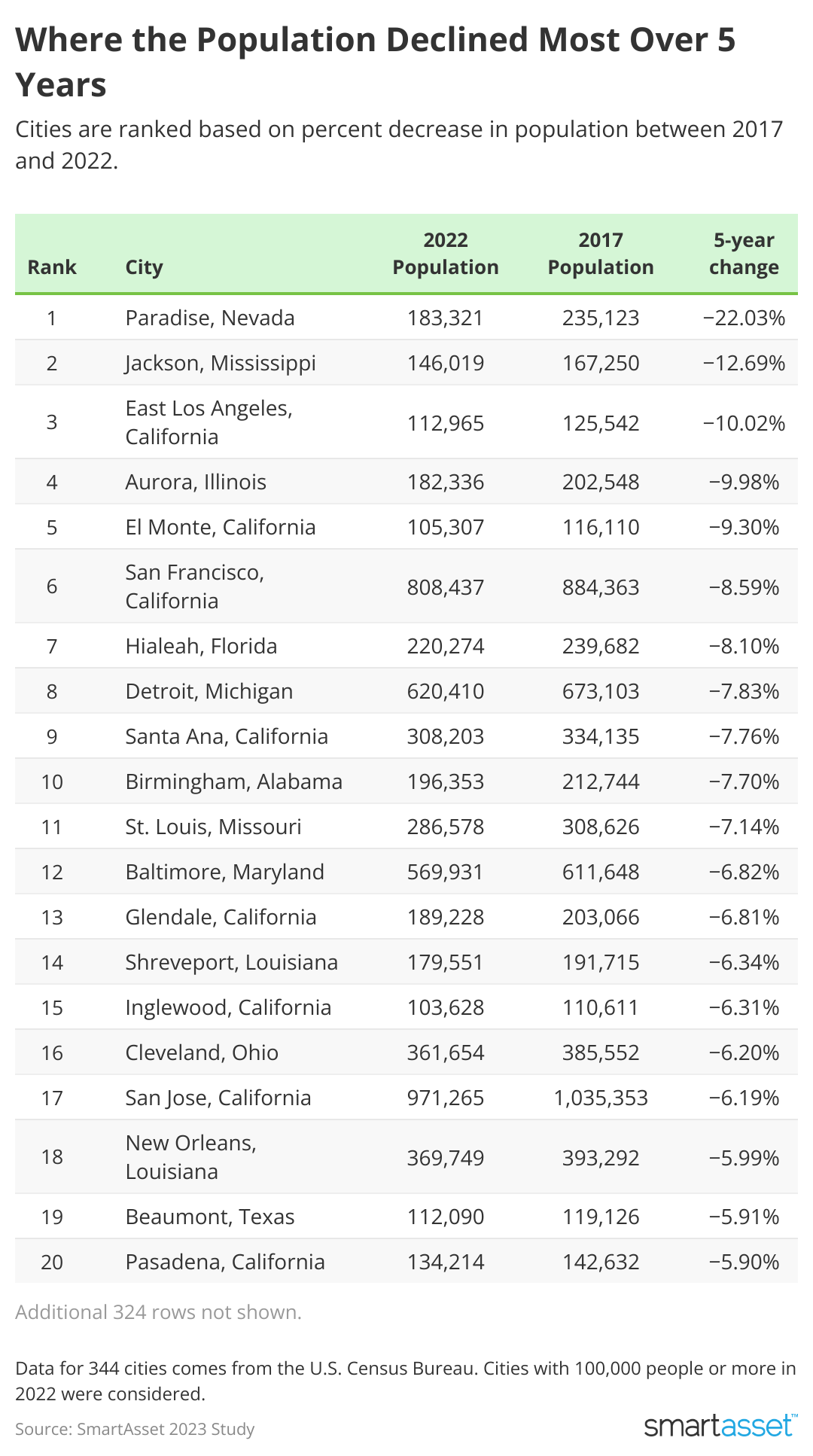These US cities lost the most people over the last five years

Canva
These US cities lost the most people over the last five years
A empty small town street in Utah
When a city’s population declines – whether birth rates go down, deaths increase, or people simply move to another area – it can affect the housing market, small businesses, employment and other factors. Paying attention to demographic changes can help residents, governments and businesses understand new trends and inform how to best position themselves.
With this in mind, SmartAsset ranked 344 of the largest U.S. cities based on the largest population declines over five years between 2017 and 2022.
Key findings
- Paradise, Nevada lost 22% of its population despite population growth across the Southwest. Many cities in Nevada, Arizona and Texas topped the list for the highest population growth between 2017 and 2022, but Paradise bucks that trend. The latest population count was 183,321, down from 235,123 residents in 2017. This rate of decline is almost double that of second-place Jackson, Mississippi (-12.7%).
- California cities make up 40% of the top 25 places where the population decreased most. El Monte had the fifth-highest population shrinkage studywide, losing 9.3% of its population. San Francisco ranked sixth overall with a 8.6% decrease over five years. Santa Ana (-7.8%), Glendale (-6.8%), Inglewood (-6.3%), San Jose (6.2%), Pasadena (-5.9%), Concord (-5.5%), and Corona (5.0%) also topped the list.
- The population of Elgin, Illinois decreased by 7% in just one year. While this city has a five-year population decline of 4.2%, Elgin saw the highest one-year population decline. Residents here dropped to 109,634 in 2022 from 117,850 just a year prior.
![]()

SmartAsset
Here’s a closer look at the top 10 cities with the biggest 5-year population declines
A chart showing the 20 cities where the Population Declined Most Over 5 Years
1. Paradise, Nevada
Paradise experienced a significant population drop of about 22.0% over the past five years, resulting in a 2022 population of 183,321. The city’s gender distribution leans slightly towards females at 50.9%.
2. Jackson, Mississippi
Jackson saw a decline of approximately 12.7% in its populace from 2017 to 2022. Most recently housing 146,019 residents, the city has a predominant female majority at 53.46%.
3. East Los Angeles, California
East LA reported a population reduction of roughly 10.0% in the last five years. The 2022 census showed 112,965 residents, with men slightly outnumbering women at 51.7%.
4. Aurora, Illinois
Aurora faced a population decrease of nearly 10.0% over five years. The 2022 census recorded 182,336 inhabitants, with females slightly outnumbering males at 50.5%.
5. El Monte, California
The population dropped by approximately 9.3% in El Monte over the past five years. Most recently, the city’s population is 105,307, with a near-equal gender distribution between men and women.
6. San Francisco, California
San Francisco saw a 8.6% reduction in its populace. As of 2022, the city housed 808,437 individuals, with a marginal male majority at 51.3%.
7. Hialeah, Florida
Hialeah had an 8.1% decline in residents. This put the 2022 count at 220,274 with women outnumbering men at 52.9%.
8. Detroit, Michigan
In Detroit, the population decreased 7.8% since 2017. With 620,410 residents in 2022, the gender ratio is skewed toward women at 52.5%.
9. Santa Ana, California
Santa Ana’s population fell approximately 7.8%. The 2022 population of the city is 308,203, with a near-even split of 50.6% men and 49.4% women.
10. Birmingham, Alabama
Birmingham experienced a population decrease of around 7.7% since 2017. With 196,353 residents in 2022, women in the city make up the majority at 53.2%.
Data and methodology
This study examined the 344 U.S. cities that had a population of 100,000 or higher in 2022, according to the U.S. Census Bureau’s 1-Year American Community Survey. Cities were ranked by five-year population decline between 2022 and 2017. The population of men and women as a percentage of the whole was also examined. Population data includes people of all ages. Changes in population may be due to births, deaths or migrations.
This story was produced by SmartAsset and reviewed and distributed by Stacker Media.
